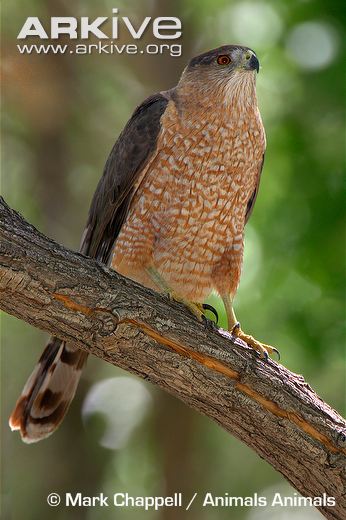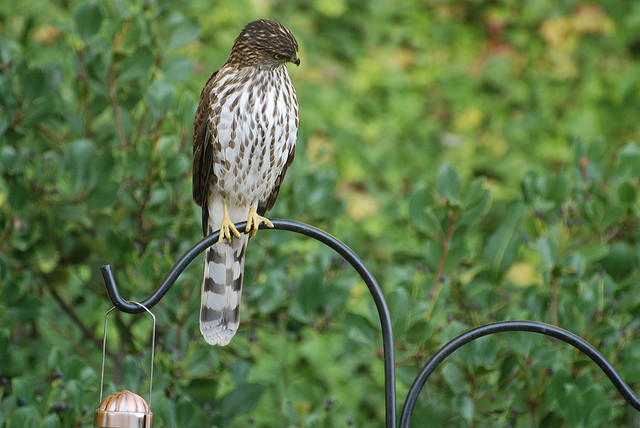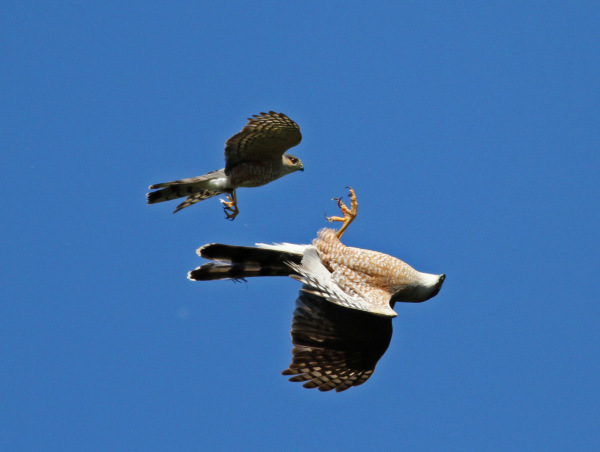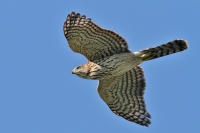
The Cooper's tail tip is rounded and graduated in length. Thick, dark bars span the entire length, ending with a white terminal bar. Adults (shown at left) have a dark cap, steel-gray back and orage-and-white barred underparts. Juveniles (shown below at right) have lighter-colored heads, whitish bellies and brown-colored backs mottled with white.
This excellent flyer (see photo at bottom of a Cooper's being mobbed by the very similar looking Sharp-shinned Hawk) can be found throughout Wisconsin in habitats ranging from deep forests to leafy backyards. It ambushes prey by sneaking up at feeding spots from behind or slicing through tree canopies unexpectedly. Another technique a Cooper's will use is to fly fast and low, abruptlyly change directions up and over an object, and attack the unsuspecting prey on the other side. They will eat birds nearly their own size, dragging them into the underbrush after capture, however prefer smaller birds that are easier to carry away.
 This stealthy hawk has adapted well to city life and takes advantage of neighborhood bird feeders (picture at right). It will wait silently upon a tree, lightpole or fencepost and will often remain perched when approached from beneath.
This stealthy hawk has adapted well to city life and takes advantage of neighborhood bird feeders (picture at right). It will wait silently upon a tree, lightpole or fencepost and will often remain perched when approached from beneath.
A Cooper's flight pattern is similar to other accipiters. It uses a flap, flap, glide motion and rarely continuously flaps even if flying over large open areas. It has stiff and shallow wing beats which come from the shoulder.
 The crow-sized Cooper's are fairly quiet out of breeding season, but vocalize a distict and loud cak-cak-cak when courting or calling. They are monogamous, though not always for life, sometimes changing partners the next breeding season. Cooper's will have one brood of 3-5 chicks each season. They become independent at 8 weeks of age and usually become sexually mature at 2 years of age.
The crow-sized Cooper's are fairly quiet out of breeding season, but vocalize a distict and loud cak-cak-cak when courting or calling. They are monogamous, though not always for life, sometimes changing partners the next breeding season. Cooper's will have one brood of 3-5 chicks each season. They become independent at 8 weeks of age and usually become sexually mature at 2 years of age.
Fun Facts:
- The average life span of a Cooper's Hawk in the wild is a year and a half, although the oldest known wild Cooper's lived to be 12 years of age.
- The Cooper's Hawk is also commonly referred to as the "Chicken Hawk" because of it reputation for raiding poultry yards. Other common names for the raptor include "Blue Darter" and "Hen Hawk."
- A Cooper's Hawk leads a dangerous life! Their stealthy predatory style of quickly cutting through thick brush takes a toll on their bodies. A study of 300 deceased Cooper's found that 23 percent of the birds had old fractures in their chest and/or on their furculars.
- Male Cooper's tend to be much smaller in size than the female. They act submissively around the female, bringing food to the nest and helping with parental care.
- Cooper's Hawks occasionally supplement their diets with small mammals and reptiles.
- The typical method Cooper's Hawks use to kill prey is by holding the bird and squeezing it to death. Cooper's have also been documented however, to hold their prey underwater and drown it to death.
- Cooper's Hawks were named after William Cooper who collected the first specimen.
- Cooper's Hawks west of the Mississippi tend to be much smaller than Cooper's east of the river. They average 1/5 the size of the eastern birds.
* This article was written using the help of The Crossley ID Guide: Eastern Birds by Richard Crossley, The National Geographic Guide to the Birds of North America by Jon L. Dunnand & Jonathan Alderfer, The Sibley Guide to Birds by David Allen Sibley, the Cornell Lab of Ornithology website - allaboutbirds.org, and the iBirdPlus app for smart phones.
* Photo of Cooper's Hawk being mobbed by a Sharp-shinned Hawk credited to projectfeederwatch.wordpress.com. Photo of Cooper's sitting on bird feeder by Linda Ryder. Picture of juvenile Cooper's Hawk by Josh Engel.





